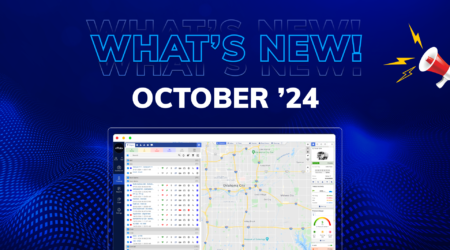Fleet Driver Management Software: Key Benefits
In today’s fast-paced world, managing a fleet of vehicles and drivers efficiently is crucial for businesses. Fleet driver management software has become an indispensable tool for companies that rely on transportation for their operations. This software not only streamlines fleet management but also enhances driver performance and safety. In this blog, we’ll explore the key benefits of fleet driver management software and how it can transform your business operations.
What is Fleet Driver Management Software?
Fleet driver management software is a comprehensive solution designed to oversee, track, and manage the various aspects of fleet operations. This includes monitoring vehicle locations, driver behavior, maintenance schedules, and fuel consumption. By integrating these functionalities, the software provides fleet managers with real-time data and insights to make informed decisions.
Why is Fleet Driver Management Software Important?
Fleet driver management software plays a crucial role in modern fleet operations, offering a myriad of benefits that contribute to the overall success of businesses. Here’s why it’s essential:
1. Efficiency and Productivity
Efficiency is the cornerstone of fleet management, and fleet driver management software enhances operational efficiency in multiple ways. By automating routine tasks, optimizing routes, and streamlining communication between fleet managers and drivers, the software minimizes downtime and maximizes productivity. This allows businesses to accomplish more with fewer resources, ultimately driving profitability.
2. Safety and Compliance
Safety is paramount in the transportation industry, and fleet driver management software helps businesses prioritize safety and compliance. By monitoring driver behavior, enforcing adherence to safety regulations, and facilitating regular vehicle inspections, the software reduces the risk of accidents and ensures compliance with industry standards. This not only protects drivers and assets but also mitigates legal and financial liabilities for businesses.
3. Cost Reduction
Controlling costs is a top priority for fleet operators, and fleet driver management software enables significant cost savings across various aspects of fleet operations. By optimizing fuel usage, minimizing vehicle wear and tear, and preventing unauthorized vehicle use, the software reduces fuel expenses, maintenance costs, and operational inefficiencies. Additionally, by proactively addressing maintenance needs and compliance requirements, businesses can avoid costly repairs, penalties, and downtime.
4. Data-Driven Decision-Making
In today’s data-driven world, access to real-time insights is invaluable for informed decision-making. Fleet driver management software provides businesses with comprehensive data and analytics on fleet performance, driver behavior, fuel consumption, and more. This actionable intelligence enables fleet managers to identify trends, pinpoint areas for improvement, and implement strategic initiatives to enhance efficiency and profitability.
5. Customer Satisfaction
Customer satisfaction is a key differentiator in a competitive market, and fleet driver management software plays a vital role in meeting customer expectations. By optimizing routes, ensuring timely deliveries, and providing transparency through real-time tracking and communication, businesses can deliver superior service levels that delight customers. This fosters long-term relationships, drives repeat business, and strengthens the brand reputation in the marketplace.
6. Future-Proofing
As technology continues to evolve, businesses must adapt to stay competitive and future-proof their operations. Fleet driver management software represents a forward-thinking investment that positions businesses for success in the digital age. By embracing innovation, leveraging advanced features, and staying ahead of industry trends, businesses can gain a competitive edge and thrive in an ever-changing landscape.
Fleet driver management software is more than just a tool—it’s a strategic asset that empowers businesses to optimize efficiency, enhance safety, reduce costs, and deliver exceptional service. By embracing this technology, businesses can unlock new levels of success and drive sustainable growth in the dynamic world of fleet management.
Key Benefits of Fleet Driver Management Software
1. Improved Driver Performance
One of the primary benefits of fleet driver management software is the improvement in driver performance. The software monitors driving behaviors such as speed, acceleration, braking, and idling. By identifying risky behaviors, fleet managers can provide targeted training and feedback to drivers. This not only enhances safety but also promotes a culture of accountability and continuous improvement.
2. Enhanced Safety
Safety is paramount in fleet management. Fleet driver management software helps in reducing accidents and ensuring compliance with safety regulations. The software provides real-time alerts for unsafe driving practices, enabling immediate corrective actions. Moreover, it keeps track of driver hours and ensures adherence to regulations such as Hours of Service (HOS) rules, preventing driver fatigue and related accidents.
3. Efficient Route Planning and Optimization
Efficient route planning is essential for reducing fuel consumption and improving delivery times. Fleet driver management software uses GPS technology to optimize routes based on traffic conditions, road closures, and other variables. This not only saves time and fuel but also enhances customer satisfaction.
4. Reduced Operational Costs
Operational costs can be a significant burden for fleet operators. Fleet driver management software helps in reducing these costs by optimizing fuel consumption, minimizing vehicle wear and tear, and preventing unauthorized vehicle use. Additionally, it provides insights into maintenance needs, ensuring timely servicing and reducing the likelihood of costly breakdowns.
5. Enhanced Vehicle Maintenance
Regular maintenance is crucial for the longevity and performance of fleet vehicles. Fleet driver management software tracks maintenance schedules and provides alerts for upcoming services. This proactive approach ensures that vehicles are well-maintained, reducing downtime and extending their lifespan. Moreover, it helps in maintaining a detailed service history, which is valuable for resale purposes.
6. Real-Time Monitoring and Reporting
Real-time monitoring is a key feature of fleet driver management software. It provides fleet managers with up-to-date information on vehicle locations, driver activities, and overall fleet performance. The software also generates comprehensive reports, offering insights into various metrics such as fuel efficiency, driver performance, and vehicle utilization. These reports are essential for data-driven decision-making and continuous improvement.
7. Compliance with Regulations
Compliance with various regulations is a critical aspect of fleet management. Fleet driver management software ensures that all regulatory requirements are met, from vehicle inspections to driver certifications. It provides automated reminders for license renewals, safety checks, and other compliance-related tasks. This reduces the risk of penalties and ensures that the fleet operates within legal boundaries.
8. Improved Customer Service
Customer satisfaction is a key driver of business success. Fleet driver management software enhances customer service by ensuring timely and accurate deliveries. The software allows customers to track their shipments in real-time, providing transparency and peace of mind. Moreover, it helps in addressing customer queries and complaints promptly by providing detailed information on delivery status and driver performance.
9. Increased Productivity
By automating routine tasks and providing real-time insights, fleet driver management software significantly boosts productivity. Fleet managers can focus on strategic decision-making rather than getting bogged down by administrative tasks. Drivers can also perform their duties more efficiently, thanks to optimized routes and clear instructions. This leads to overall improved operational efficiency and business performance.
10. Better Fuel Management
Fuel is one of the largest expenses for fleet operators. Fleet driver management software provides tools for monitoring and optimizing fuel usage. It tracks fuel consumption patterns, identifies areas of wastage, and suggests measures for improvement. By adopting fuel-efficient driving practices and optimizing routes, fleets can achieve significant savings on fuel costs.
How Fleet Driver Management Software Works
Fleet driver management software integrates various technologies to provide a holistic view of fleet operations. Here’s a breakdown of its key components:
GPS Tracking
GPS tracking is at the core of fleet driver management software. It provides real-time location data for all fleet vehicles, enabling efficient route planning and monitoring. GPS tracking also helps in recovering stolen vehicles and reducing unauthorized usage.
Telematics
Telematics systems collect data on vehicle performance and driver behavior. This includes metrics such as speed, acceleration, braking, and idling. Telematics data is crucial for monitoring driver performance, ensuring vehicle health, and optimizing fuel usage.
Dashboard and Reporting Tools
The software features a centralized dashboard that provides an overview of fleet operations. It displays real-time data and alerts, allowing fleet managers to make informed decisions quickly. Reporting tools generate detailed reports on various aspects of fleet performance, aiding in long-term planning and analysis.
Maintenance Management
Maintenance management tools track service schedules and provide reminders for upcoming maintenance tasks. They also maintain a detailed service history for each vehicle, helping in proactive maintenance and reducing the risk of breakdowns.
Compliance Management
Compliance management tools ensure that the fleet adheres to all regulatory requirements. They provide automated reminders for inspections, certifications, and renewals, ensuring that the fleet remains compliant with industry standards.
Fleet driver management software encompasses various components to provide a comprehensive solution for fleet operations. In addition to GPS tracking, telematics, maintenance management, compliance tools, and communication features, it also includes specialized modules for driver management and driver app integration. Let’s delve into these additional components:
Driver Management
Driver management is a vital aspect of fleet operations, and fleet driver management software streamlines this process efficiently. Within the platform, fleet managers can add and manage driver profiles, including personal information, licensing details, certifications, and performance metrics. Each driver’s history and records are stored securely within the system, ensuring compliance with regulatory requirements and facilitating seamless communication.
Key Features of Driver Management:
- Driver Assignment: Fleet managers can assign drivers to specific vehicles or trips directly within the platform. This feature streamlines the allocation process and ensures that vehicles are appropriately manned for each journey.
- Driver Performance Tracking: The software tracks individual driver performance metrics, such as driving behavior, adherence to schedules, and compliance with safety regulations. This data enables fleet managers to identify high-performing drivers and address any performance issues proactively.
Driver App Integration
To facilitate seamless communication and data exchange between drivers and fleet managers, fleet driver management software often includes a dedicated driver app. This app empowers drivers with essential tools to perform vehicle inspections, manage expenses, and communicate with dispatchers directly from their mobile devices.
Key Features of Driver App Integration:
- Vehicle Inspection: The driver app allows drivers to conduct pre-trip and post-trip vehicle inspections conveniently. They can capture photos, record notes, and report any issues directly within the app, ensuring that vehicles are in optimal condition before hitting the road.
- Expense Management: Managing expenses is simplified through the driver app. Drivers can record fuel purchases, toll fees, and other expenses incurred during trips, eliminating the need for manual paperwork. This streamlines reimbursement processes and ensures accurate expense tracking.
By integrating driver management capabilities and a dedicated driver app into fleet driver management software, businesses can optimize their fleet operations further. From assigning drivers to vehicles and trips to empowering drivers with essential tools for vehicle inspection and expense management, these components enhance efficiency, safety, and compliance across the fleet.
Choosing the Right Fleet Driver Management Software
Selecting the right fleet driver management software is crucial for reaping its benefits. Here are some factors to consider:
1. Features and Functionality
Ensure that the software offers all the necessary features, such as GPS tracking, telematics, maintenance management, and compliance tools. It should also provide real-time monitoring and reporting capabilities.
2. Ease of Use
The software should have an intuitive interface that is easy to navigate. Both fleet managers and drivers should be able to use it without extensive training.
3. Scalability
Choose software that can scale with your business. It should be able to handle an increasing number of vehicles and drivers as your fleet grows.
4. Integration Capabilities
The software should integrate seamlessly with your existing systems, such as ERP and CRM platforms. This ensures smooth data flow and reduces administrative overhead.
5. Customer Support
Reliable customer support is essential for addressing any issues that may arise. Choose a provider that offers prompt and effective support services.
6. Cost
Consider the cost of the software and its return on investment. While it may require an upfront investment, the long-term benefits in terms of cost savings and improved efficiency make it worthwhile.
Implementation and Adoption
Implementing fleet driver management software requires careful planning and execution. Here are some steps to ensure successful adoption:
1. Assess Your Needs
Conduct a thorough assessment of your fleet management needs. Identify the key pain points and determine how the software can address them.
2. Choose the Right Software
Based on your assessment, select the software that best meets your requirements. Ensure that it offers the necessary features and fits within your budget.
3. Plan the Implementation
Develop a detailed implementation plan that outlines the steps, timeline, and resources required. This should include data migration, system integration, and user training.
4. Train Your Team
Provide comprehensive training for both fleet managers and drivers. Ensure that they understand how to use the software effectively and are aware of its benefits.
5. Monitor and Evaluate
After implementation, continuously monitor the software’s performance and its impact on your fleet operations. Collect feedback from users and make necessary adjustments to optimize its usage.
Conclusion
Fleet driver management software is a powerful tool that can transform your fleet operations. By improving driver performance, enhancing safety, optimizing routes, and reducing operational costs, it provides numerous benefits that contribute to the overall success of your business. Additionally, it ensures compliance with regulations, boosts customer satisfaction, and increases productivity.
Investing in fleet driver management software is not just about adopting new technology; it’s about making a strategic decision that can significantly impact your bottom line. Embrace the future of fleet management and experience the myriad benefits it offers.





